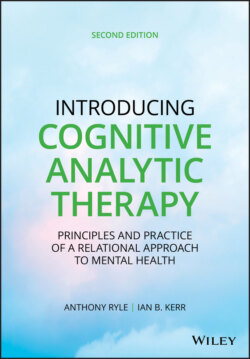Читать книгу Introducing Cognitive Analytic Therapy - Anthony Ryle - Страница 53
Sign Mediation
ОглавлениеLong before language is acquired, children are active in the presence of others who, by gesture, expression, movement, rhythms, mimicry, sounds, and by jointly created rituals and symbols, communicate wishes, intentions, and meanings. Repeated parental responses which reflect, amplify, control, or ignore the child's actions and expressions offer a commentary on the child's activity, whether its object is a part of its own or its mother's body or a pattern of light or a spoon or a toy. These responses shape the child's understanding of the world and also constitute a defining example of the parent–child relationship and are hence a source of the sense of self.
From a Vygotksian viewpoint, signs are created and used between people or within cultures. A well‐known example of the creation of meaning and intention is provided by Clark's (1978) extension of Vygotsky's account of what happens when a child attempts to reach an object beyond its range. Whether it elicits from the caretaker assistance, encouragement, or removal from possible harm, the fact of the response transforms the attempt into a gesture which, with repetition, can come to serve as a statement of intent and as a means of influencing the caretaker, that is to say it becomes a jointly elaborated interpsychological sign (see Leiman, 1992).
Within psychoanalysis, Winnicott's understanding of the transitional object as standing for the mother in her absence was an example of such an interpsychological sign and was related to his insistence that the mother–baby dyad was the proper focus of attention for developmental psychology. Language is a shared system of signs which is “de‐contextualized” and hence flexible, allowing more abstract and theoretical forms of thought. It creates for the individual (as it did, in the course of evolution, for the species) the possibility of conscious self‐knowledge and it represents an important human way of making sense of the world. However, as noted previously, important formative, early, relational experience also occurs pre‐verbally in the first couple of years of life. As such this remains beyond the reach of conscious linguistic memory or recall although its effects may be incorporated at a deeper bodily level and be profound.
